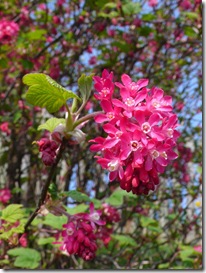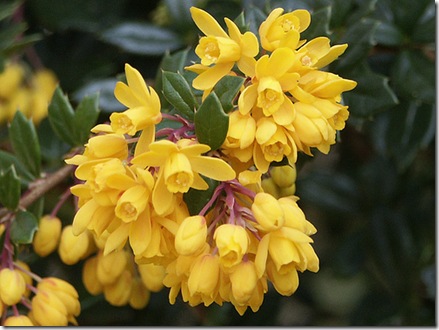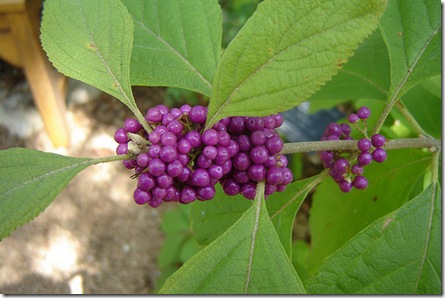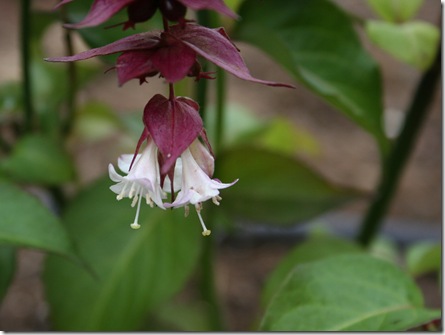Now that we’ve talked about trees to attract birds, and how to attract birds using feeders and birdbaths, I want to get on to some of my very favorite shrubs. From the rich purple berries of Callicarpa to the hanging clusters on Leycesteria, I’ve chosen my top five shrubs to plant for the birds:
Berberis darwinii or Darwin’s Evergreen Barberry
Most Barberries are deciduous, but Darwin’s Barberry is the rare evergreen, with shiny deep green leaves that make a great year-round backdrop.
In mid-winter, it bursts into bright golden bloom, with clusters of flowers covering the plant. The spectacular bloom is followed by profuse deep blue berries, spurring a garden party for the birds!
Darwin’s Barberry has a pretty fountain-like habit, and while it’s slow to get going, once it’s established it will take off and grow into a sturdy evergreen screen 6-8’ tall and wide. The leaves are prickly, which has the benefit of making it deer-resistant, but also means you should plant it towards the back of the bed, and give it enough room so you don’t have to squeeze past it or prune it.
The upright habit looks great with a softly-textured or flowing conifer such as Tsuga canadensis, the Canadian Hemlock, or Larix decidua ‘Pendula’, a Weeping European Larch.
Callicarpa or Beautyberry
I’ll admit it: I’m a sucker for purple. When we bought our home, the first thing I did? Painted my office walls a cheering shade of lavender.
So it should come as no surprise that I champion Beautyberry, with its really-truly purple berries in fall! It has fairly nice pink flowers in spring, but man, those berries! They come out in late summer and look great against the leaves, then cling onto the bare twigs through most of the winter, finally getting eaten by the birds or shriveling in February.
‘Profusion’ gets 6-7’ around, while ‘Early Amethyst’ gets to about 4-5’. Both need full sun in order to berry well. They do appreciate some summer water, though once they are mature they do allright without it here on the coast. I like Beautyberry with the reddish new growth and golden summer color of either ‘Magic Carpet’ or ‘Goldflame’ Spirea.
Ribes sanguineum or Flowering Currant
 This Pacific Northwest native is one of my favorite landscaping shrubs. It’s tough and easy to grow, has a graceful upright habit, and the drooping white or pink flowers harmonize nicely with other spring bloomers like Wisteria.
This Pacific Northwest native is one of my favorite landscaping shrubs. It’s tough and easy to grow, has a graceful upright habit, and the drooping white or pink flowers harmonize nicely with other spring bloomers like Wisteria.
It has the benefit of being attractive both as a nectar plant for hummingbirds when it blooms, and of providing berries for the other birds in mid-summer. I love the fresh green foliage next to plants that have dark green or purple leaves, and they go great in the same garden area as Bigleaf (macrophylla) Hydrangeas, since the foliage colors and loose habits harmonize well.
Try ‘White Icicle’ or ‘Alba’, which have white flowers and get to 6-8’, or ‘King Edward VII’, 6’, which people persist in calling red but looks like a bright pink to me.
Viburnum plicatum tomentosum or Doublefile Viburnum
All Viburnums are fantastic for the birds, but the Doublefile Viburnum is the best. Its tiered, horizontal branching pattern is like a playground for them! Even though it goes dormant, this is one of the winter bird hotspots – chickadees and sparrows are jumping from branch to branch and rustling about. Every year when pruning, I find finished hummingbird and other nests in the topmost branches.
When it leafs out in spring, the fresh green color is so cheering; then by early summer it is covered in pretty white lacecap blooms which hover above the branches. The berries in summer look like clusters of Red Hots, and then it provides a purple-red fall color.
To get your Viburnum to berry, be sure that you have a different variety of Doublefile Viburnum nearby, even in a neighbor’s garden, to pollinate it. Even without the berries, though, this is a wonderful habitat plant to enjoy in all the seasons.
The neatest thing about it is how versatile it is. I can’t think of any plant that wouldn’t look good with it. It does as well in a Japanese style of planting (try ‘Fujiensis’) as in an English cottage garden (try ‘Shasta’ or ‘Summer Snowflake’), and there are varieties from 4’ around (‘Newport’), to 12’ or wider (‘Mariesii’). Whichever one you choose, be sure to give it the room it needs, as constant pruning tends to ruin the pretty tiered form.
Leycesteria formosa or Himalayan Honeysuckle
Oh how I love you Leycesteria. When I lived in a tiny apartment with a tinier patch of garden, I was dying for some screening. The ill-mannered children in the complex, and their even more ill-mannered parents, hollered day and night, and the basketball court provided a constant backdrop to my thoughts.
In a fit of desperation I bought this new-to-me plant, to try and gain some peace. At the time, the hanging clusters of burgundy bracts and bell-shaped white blossoms were just a bonus; the blackish berries too. I heard “will be 7’ in two years’ time” and I pulled out my wallet!
I couldn’t believe it when the one-gallon plant grew to a solid 4’ in the first year – in hard subsoil! The next year it was hanging over the fence, attracting hummingbirds with its 8 months of blooms, and other birds with the berries.
I had time to fall in love with it before leaving; the deep green leaves and graceful, vase-like habit charmed me, and the rich black berries against the hanging burgundy bracts looked suitably goth for my tastes.
Make sure you give them plenty of room – they will arch upwards to 8’ and beyond, and though you can put a few shade lovers like Hellebores around their feet, you definitely want to give them room to grow up and cascade over again – so no shrubs within a 5’ radius.
‘Golden Lanterns’ is a tropical-looking gold-leaved variety that is otherwise pretty much identical to the species.
I hope this gives you some inspiration to enjoy planting for the birds. It’s such a pleasure to look out and see them full of energy and mischief this time of year. Later this week we’ll cover a few of the smaller plants to tuck into your garden to attract birds.




11 responses to “Shrubs to Attract Birds – Planting for Year-Round Berries and Habitats”
I enjoyed this post very much and you put so much effort in to the quality of your blog. Excellent pictures and descriptions.
Anna/Flowergardengirl’s last blog post..A Weeping Willow Tribute to Black History Month
Wow! The Himalayan Honeysuckle is GORGEOUS! I also really like the Currant and Barberry. While I really enjoy container gardening, when I see really beautiful shrubs and trees, I am a little jealous of in-ground gardeners.
Fern’s last blog post..Tips for Growing Plants from Seeds
Geneveive:
Oh how I fell when I saw the gorgeous Lycesteria formosa, and oh how I bemoaned living in a Zone 5 gardening area when I checked to see it’s hardiness. This only convinces me that I will forever choose plants that want more southerly or western climates. Of course this hasn’t stopped me from experimenting. Alas, another beauty to file away for when I can live on the west coast!
teza’s last blog post..Winter hangs on tightly!
Awesome! I have planted some fruit trees and am reading up on the “edible forest garden” concept for the back half of my lot. I want to attract birds so they’ll eat the pest insects. Also, birds are fun to watch. 😉
Lindsay’s last blog post..How to Get Paid Twice for Your Book
Anna, thank you so much for your kind words! That means a lot to me as I love your blog!
Fern, I have not personally tried the Himalayan Honeysuckle in a pot, but I read on at least one site that it does well as a container plant! If you try it you will have to let us know. The Darwin’s Barberry works well as a container plant for sure. It grows so slowly when potted that it stays healthy. It does have those prickles though!
Teza, you’ll have to check into it, but I heard a rumor online that people in cold zones like yours have been growing Leycesteria as a perennial, and it goes dormant to the ground each year, and grows back to about 5′ by the end of the season. So if you have fallen in love you may like to check around online and see if anyone in your zone has tried it!
That’s a great idea, Lindsay! I was so excited to read your post the other day about productivity and fruit trees – you are so right! Focusing on one thing at a time is key. And I love the “edible forest garden” concept. Don’t forget blueberries!
Hi Genevieve, I love the thought of berries and have been planting several over the past couple of years with that in mind. Three Viburnums named Cardinal Candy are still small but promise loads of food for the birds and beauty for the humans. The pollinator Winterthur is near along with Brandywine, Blue Muffin and Opulus. If that doesn’t bring the berries, I might have to give up! Your match of beautyberry and magic carpet sounds perfect. That spiraea, is a fave here as well. Never heard of the evergreen barberry, what nice flowers it has too. Thanks again for your info!
Frances
Frances’s last blog post..Thirsty Throngs
The Callicarpa is so stunning. I too am a sucker for purple. Many years ago I carpeted my entire small house in that color and I absolutely loved it. I think we’re soul sisters! And the Ribes, I have the Alba and I just love the look of the flower clusters on bare branches. I’m training it to climb and wind around my deck. It looks like the EARLY AMETHYST will fit nicely on my terrace in SF.
Be still my heart! You have written of some of my favorite plants (okay, I admit that I have many favorites, but these are two of my most favorite favorites!)…Calicarpa and Leycesteria formosa! I’ve yet to plant a Calicarpa here, but the Leycesteria is in the ground, waiting to spring forth it’s beauty. Just another reason I can hardly wait for spring and summer!
Another most excellent post. 🙂
Aerie-el’s last blog post..RED, WHITE, AND GREEN
I think any and all viburnums are great for birds and people. I had no idea barberries could be evergreen (your cute darwinii is two zones too warm for me!). The ones common here in SE Michigan (Berberis thunbergii) are deciduous and on the city of Ann Arbor’s invasive plant list. I do have a few, because their prickliness is handy in some parts of my garden where I don’t want people walking through (I live near a park and footpath and for a long time people were cutting through my property instead). I love the beauty berry; it’s gorgeous! I also think Aronia are good for berries and blooms. Tweet tweet. 🙂
Monica’s last blog post..GBBD – At last!
[…] covered my favorite trees and larger shrubs to attract birds; now I want to talk about some of the smaller plants to bring the birds and hummingbirds flying to […]
Could you kindly confirm me what is the scientific name of the yellow flower – Berberis darwinii or Darwin’s Evergreen Barberry on your site. I was looking for Callicarpa macrophylla and came across your site. Is this flower having some fragrance? Where did you find this plant/tree, I mean any store or botanical garden etc. Can you give me some reference.